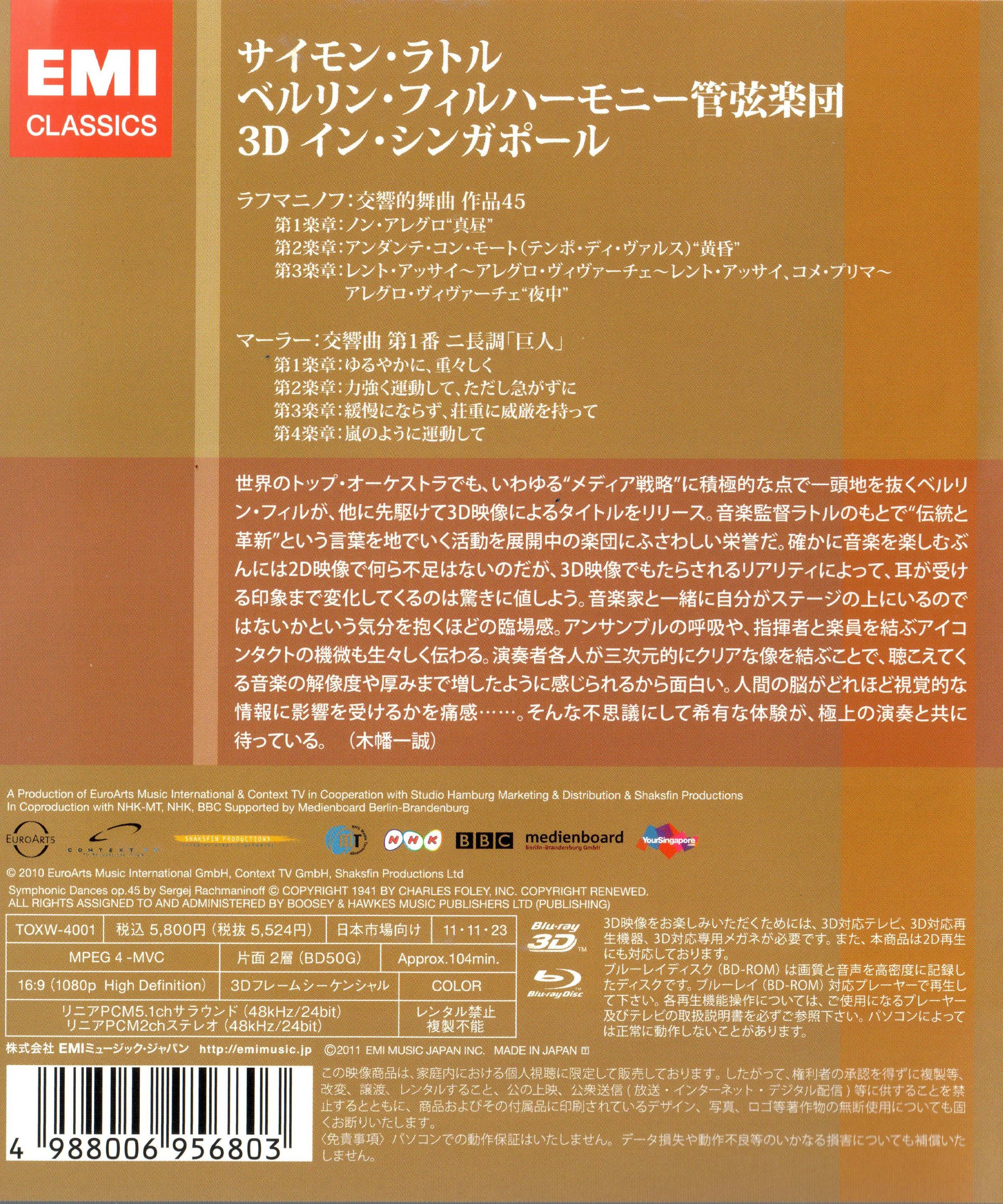

Berliner Philharmoniker 3D in Singapore concert. Simon Rattle conducts the Berliner Philharmoniker in the Rachmaninov Symphonic Dances and Mahler Symphony No. 1. This was shot in Singapore in 3D for the Japanese market. The package has practically nothing in English except the title. The video was shot at 23.976 Hz, which is the speed for motion picture film. This title plays fine on a 2D display. On our new 3D player, it plays in 3D. But we can use a toggle on the TV remote control to switch to 2D. Released 2011, we understand this title is restricted to Region A and has 5.1 PCM sound output. 2D Grade: C- 3D Grade: D
The Mahler symphony is the major item on this disc. First let's consider the merits of the Mahler in 2D. Then we will have additional comments about the 3D version.
Unlike most of the symphony HDVDs we are now getting, the sound quality on subject disc is weak. I question whether there was enough top-quality gear available to record this large work. The sound generally seems cramped with shrill woodwinds, uneven loudness in various sections (for example, the bass violins are often hard to hear), and a harp that often sounds like a ukulele. Picture quality is also odd. The video was either made with movie stock or a with a digital file treated electronically to look like a movie film (with saturated colors). The picture seems too dark (even in the 2D version), and the resolution is soft. But at the same time, too much light is reflected off the shiny instruments, especially the horns. The cameramen struggled to keep things focused, and there was often too little field-of-focus to produce good images.
Video content is even weaker than SQ and PQ. True, there is one feature of video content that I must praise. The pace of video cuts in this title is much slower than is the case with most symphony HDVDs. This makes it easier to relax and enjoy the program.
But otherwise, this video suffers from the same "DVDitis" we have noticed in many other symphony HDVDs. First, there is an overemphasis on the conductor with 66 cuts (by my count) focusing on him. Of these 66 cuts, 13 show Rattle's back as the main subject of the frame, an error I have not seen before. And there are also no fewer than 25 long-distance shots of the conductor over the backs of the musicians. Other surprising errors in this video are about 10 shots that just show the backs of musicians and nothing else! The musicians of the Berlin Philharmonic ought not to tolerate practices that interfere so drastically with what the audience wants—to see the members of the orchestra playing.
See our special article on standards for an HDVD of a symphony orchestra. The most important hallmark of a good Blu-ray record of a symphony is an abundance of whole-orchestra shots. Well, this Mahler piece does not have even a single whole-orchestra shot. (Each movement has a single 95% shot made from a balcony to the left of the stage. But this angle is unnatural and shows the backs of about 30% of the musicians.) I did count about 23 decent part-orchestra shots which to some degree mitigate the lack of whole-orchestra views.
So what do we get from the remaining cuts? There are about 65 shots of solos and small sections that clearly relate to the score. And the rest is a mixture of shots, including panning and zooming, at various distances from the band. Too often these shots don't clearly relate to what is going on in the music. But there are, on the other hand, some nice frames. See, for example, 59:40 for all the horns in a beautiful angle that lasts a long 12 seconds! Also, see 1:06:54 for a shot of the cello section taking the lead.
Now on to 3D. The 3D fad is over. But just for the record, here is what we thought of this title when we saw it in 3D:
"At the entrance, the musicians stand as the conductor mounts the podium and receives applause. There is a startling illusion that you are seeing 40 or so cardboard cut-outs with photos of the conductor and musicians standing at attention. As soon as the musicians sit down and start to move about, the cut-out illusion abates. The already dull 2D image is further darkened by the 3D glasses to the point that the picture looks grim. The brass instruments no longer look shiny—but a further loss of resolution takes away the fine detail in the images of the instruments that I expect in HDVD. Details of the men's black clothing are mostly lost in the darkness. The images of the musicians' faces suffer also. For example, the English horn player is a gent that the ladies might call "tall, dark, and handsome." He also has a lot of stylish hair. When his hair casts a shadow over his face in 3D, his features start to break up into grain on my display (see 43:46).
3D presents new challenges in framing. For example, see 40:32, a simple shot of the conductor from the waist up. Also in the lower left corner of the frame is the back of the head of a violin player. The back of the head would go completely unnoticed in 2D. But in 3D his head seems to be hovering over the equipment cabinet in the front of my home theater. I don't need any loose heads around the house. And then there are those pesky shot of out-of-focus violin bows that keep sticking out of the screen into my space. Such video gimmicks are fine in a science fiction movie, but they are silly distractions in a symphony movie.
After a while I get used to the grimness of the video and the odd artifacts and start to enjoy the depth perception. But the price I have paid is way out of proportion to the mild pleasure I get from the 3D experience. When I switch back to 2D, I'm greatly relieved to being able to see a relatively bright picture again.
Finally, before getting to a grade, let's discuss briefly the Rachmaninov Symphonic Dances. Generally, my comments about the Mahler apply also to the Dances. At 3:05 the TV director got me ready for a piano solo. I sat the fingers flying, but couldn't hear the piano. Maybe something came unplugged."
And now that I've seen the entire title, I can make the following final comment: there is not a single shot on this disc of the entire first violin section. Nor is there a decent, well-composed shot of the face of the concert master. My impression is that the TV director didn't have cameras in place to do these things.
I'll grade this in 2D first. With mediocre SQ, PQ, and content, we are in D territory. Still, the slower pace of the program together a reasonable number of part-orchestra shots drag this back up to a C- in 2D. We have to give all concerned some credit for having the guts to try an experiment in the third dimension. That will save the 3D version from an F. But the best I can do for the 3D show is to say, "don't buy this unless you have a really good reason." That's a D by our grade explanations.
It appears you can buy this title from Amazon.co.jp.